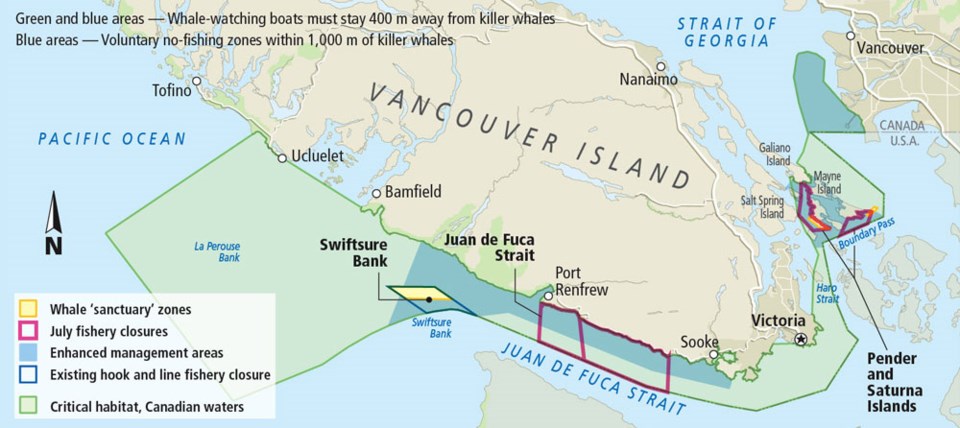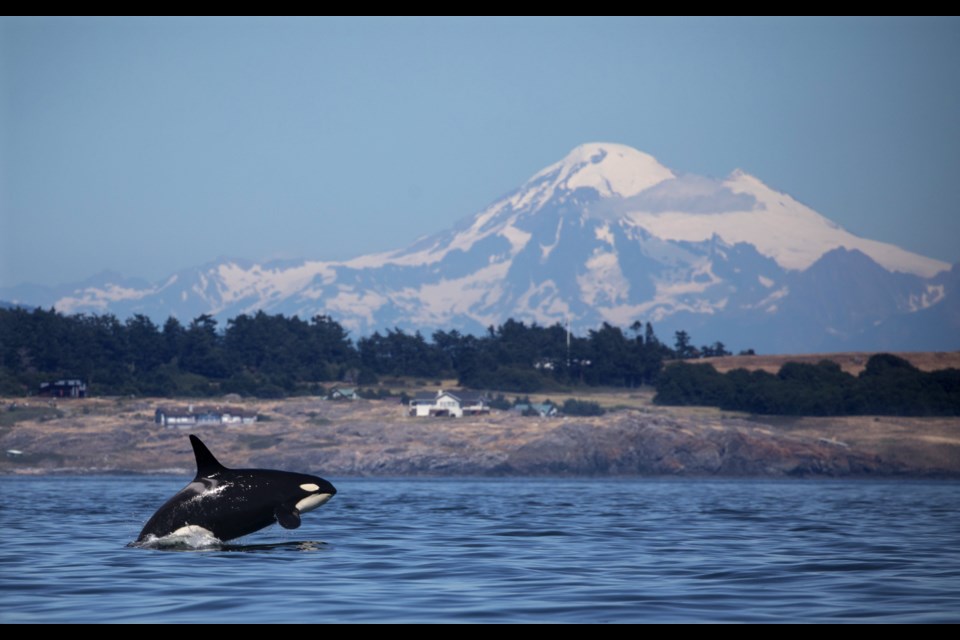The federal government stepped up its efforts to save southern resident killer whales Friday by announcing three new sanctuaries, closing a number of salmon fisheries and doubling the no-go zone around the whales for recreational vessels and whale-watching boats.
Fisheries Minister Jonathan Wilkinson said the new measures target immediate threats to the whales’ survival from vessel noise, pollution and a shortage of their preferred prey — namely chinook salmon.
“The southern resident killer whale population is clearly at risk,” he said. “While these mammals have not been overly abundant over the past number of decades, there are only 75 of these mammals left.”
Wilkinson announced that, as of June 1, whale sanctuaries in key foraging areas at Swiftsure Bank and off Pender and Saturna Islands will be off-limits to vessel traffic until Oct. 31. Exceptions will be made for emergency vessels and those engaged in Indigenous food and ceremonial fisheries.
At the same time, the government will double the mandatory no-go zone around whales to 400 metres from 200 metres for all vessels beginning June 1.
The new rules apply in critical habitat areas, which extend along southern 91ԭ�� Island through the Gulf Islands to the mouth of the Fraser River.
The government increased the protective distance around the whales from 100 to 200 metres last year.
There will be exceptions. Wilkinson said some whale-watching companies, including members of the 91ԭ�� Whale Watch Association, will enter an agreement with the government to stop offering and promoting viewing tours of southern resident killer whales.
“Those whale-watching organizations making this commitment will be allowed to approach other types of killer whales to a distance of 200 metres,” he said.
As for fishing, the minister announced recreational and commercial salmon-fishing closures in key foraging areas for the whales.
The closures, which apply to all salmon, will take effect once catch-and-release restrictions on chinook salmon fishing expire on July 15 or 31, depending on the area.
The areas will remain open to fishing for other species.

In Juan de Fuca Strait, the closures will apply to two fisheries-management areas from Port Renfrew to Sheringham Point, “though a smaller area than was the case in 2018,” Wilkinson said.
In the Gulf Islands, the restrictions will apply in areas near Mayne, Pender and Saturna Islands.
Elsewhere, the government will test voluntary “bubble” closures in enhanced-management areas that include portions of Juan de Fuca Strait, portions of the Gulf Islands and the mouth of the Fraser River.
Recreational and commercial harvesters in these zones will be asked to temporarily stop fishing and cut their speed to less than seven knots if they find themselves within 1,000 metres of killer whales.
In addition, boaters operating in critical habitat areas will be asked to voluntarily turn off echo sounders and fish finders when not in use, and turn their engines to neutral/idle if killer whales approach them and enter the 400-metre no-go zone.
For larger commercial vessels, the shipping slow-down lane in Haro Strait will expand to include Boundary Pass on June 1 in an effort to reduce boat noise. Speeds will be reduced for all vehicle classes.
“The measures being announced today have been designed to ensure that the southern resident killer whales have areas of low-disturbance and lower competition for chinook salmon, while concurrently providing ongoing opportunities for recreational fisheries,” Wilkinson told a news conference in 91ԭ��.
“They will help to promote the recovery of the southern resident killer whale in a manner that considers and accounts for the legitimate concerns of First Nations, coastal communities and the fishing and transportation industries.”
Conservation groups welcomed the new measures, calling them the boldest yet by the federal government to protect the whales.
“I think that it’s an important accomplishment what they’re announcing today,” said Misty MacDuffee of the Raincoast Conservation Foundation, part of a coalition that includes The David Suzuki Foundation, Ecojustice, Georgia Strait Alliance, Natural Resources Defense Council and WWF-Canada.
“The important things in this announcement include a greater distance on whale-watching, the beginning of the sanctuaries for whales where they won’t be disturbed by vessels, and the earlier announcement, which reduces the harvest of endangered chinook,” she said.
MacDuffee expressed concern, however, that the areas closed to salmon fishing are smaller than last year and allow less protection for the whales.
Karl Ablack, vice-president of the Port Renfrew Chamber of Commerce, said he wanted to get further clarification on the fishing closures and other measures before offering a definitive comment.
He said it was encouraging that people will still be able to fish part of Swiftsure Bank outside the new sanctuary, and that the government did not re-impose a full fin-fish closure, allowing people to fish for other types of fish.
“From Port Renfrew’s perspective, it could have been a lot worse,” he said.



